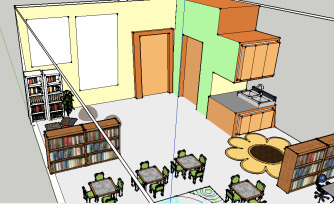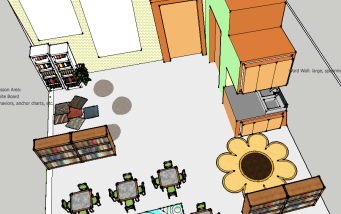
When thinking about how a classroom should look and feel based on what we know about 21st century students surrounded by 21st century technology, I chose to redesign my previous kindergarten classroom focused on the following components:
Technology: Not only will students have access to an interactive whiteboard for whole-group lessons and iPads for individual use and practice, but they will also have personal laptops. The interactive white board is located in front of the large rectangular rug. The iPads, laptops and other forms of technology are stored on the large shelving unit near my desk. Technology can be utilized in the bottom right corner of the classroom, in the Exploring Science & Technology area, but can also be used in other areas, as well. The technology will be incorporated in the classroom as motivation for student learning/participation as well as a necessary component for teaching new literacies in a 21st century classroom.


Exploration: There are multiple areas in my classroom created for learning through individual exploration and small groups. There is the cozy Reading area in front of the windows, which has comfortable bean-bag chairs, floor pillows and a large selection of books and reading and writing activities. In the Exploring Science & Technology area, chairs with wheels are incorporated for ease of use and to allow for acceptable movement and fidgeting that often accompanies learning. This area will also be used for student-led design and creating. Students can explore Math games and activities in the section of the classroom near the sink with the flower-shaped rug. Providing different areas within one classroom allows for students to daily engage in real-world activities inspired by instructional design. Not only will students be able to explore hands-on activities in the different areas of the classroom but they will be individually challenged, able to work at their own pace and will also have a choice in the activities of which they partake encouraging empowerment, confidence and self-directed learning. These components are often closely linked to student motivation which is even more closely linked to student success.

Collaboration: The classroom is separated into four main areas: Reading & Writing, Math, Exploring Science & Technology and Whole Group Learning which allow for student collaboration, participation and exploration. There are no individual desks lined up in rows but instead, there are small tables, designed for four students each, located around the edge of the Whole Group Learning rug. Developing a community in my classroom through collaboration will encourage students to feel invested in their learning and to give each task their best understanding that they are a valuable member of a team.

Aesthetics and Comfortability: Large windows are incorporated to allow maximum natural light as opposed to fluorescent, harsh lighting. A live plant is also located in the reading area. Warm and bright colors are utilized on the walls, chairs and rugs. The classroom design is intended to allow for movement, reconfiguration and exploration throughout the school day.

Student work: The entire wall behind the Reading Area is intended to allow for demonstration of student work. The students are to view this area as a museum or gallery of their best work.
But how much would it all cost? How long would it all take?
Inxpensive….
Money aside, it’s relatively simple to create various “areas” in your classroom with everyday classroom supplies and furniture you already have. Rugs can help distinguish a particular area while bookshelves can to be used as walls or barriers for separation. Painted walls and plants can also be inexpensive.
Expensive….
Adding larger windows to the classroom would be an expensive fix and would likely require a whlole-school construction redesign. My previous classroom also had tables instead of desks but they were much larger than the ones used in my redesign and could not easily be reconfigured. These new tables and chairs, however, are smaller and can be moved for various classroom activities. The Exploring Science & Technology area was a small-group work area in my previous classroom containing only a half-moon-shaped table. In my redesign, I added three large tables to support technology use and hands-on exploration as well as wheeled chairs for easy reconfiguration. I had an interactive white board in my previous classroom so that would not have to be purchased but a classroom set of laptops and iPads would cost a significant amount. Likely, grants would have to be received in order to pay for the technology incorporated in my redesign. Although this new technology is expensive, I feel it is one of the best ways to properly prepare 21st century students to live meaningfully in a 21st century world while meeting individual student learning needs and goals.
In conclusion, we must view the classroom environment as a “third teacher” that greatly influences, encourages or discourages genuine learning. “Experience design”, as this concept of the third teacher is often referred to, can be seen as a “point in time”, a “flow” and a “participation” that greatly affects the learning process (ChangSchool, 2010). We, as teachers, must approach our classroom set up and design as an environment that will foster, and not hinder, real learning.
References
ChangSchool. (Feb. 9, 2010). Tedde Ven Gelderen on experience design. YouTube. Retrieved from
OWP/P Architects, VS Furniture, & Bruce Mau Design. The third teacher. Harry N. Abrams: First Edition.
The Third Teacher (n.d.) TTT Ideas Flash Cards. Retrieved from
Third Teacher Plus, Cannon Design & Shaw Contact Group. (nd). Inside the inspired learning environment. Retrieved from
